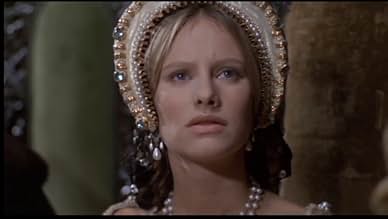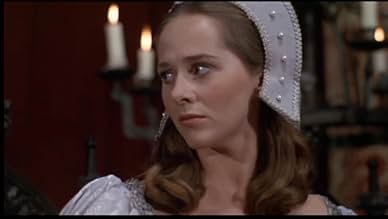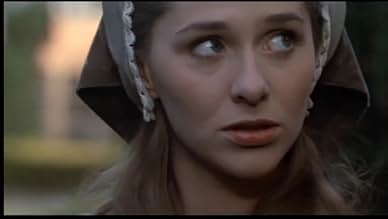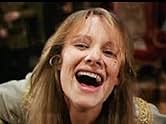AVALIAÇÃO DA IMDb
5,5/10
3,1 mil
SUA AVALIAÇÃO
Adicionar um enredo no seu idiomaIn 1500s England, a cruel witch-hunting magistrate, who often tortures innocent villagers for his entertainment, runs afoul of a witch who conjures a banshee to kill the magistrate and his f... Ler tudoIn 1500s England, a cruel witch-hunting magistrate, who often tortures innocent villagers for his entertainment, runs afoul of a witch who conjures a banshee to kill the magistrate and his family.In 1500s England, a cruel witch-hunting magistrate, who often tortures innocent villagers for his entertainment, runs afoul of a witch who conjures a banshee to kill the magistrate and his family.
- Direção
- Roteiristas
- Artistas
Elisabeth Bergner
- Oona
- (as Elizabeth Bergner)
Hilary Heath
- Maureen Whitman
- (as Hilary Dwyer)
Victoria Fairbrother
- Margaret Donald - Witch
- (as Pamela Farbrother)
Avaliações em destaque
This is a nasty bit of business made by AIP during that dreary period where the colorful, fun horror movies of the '60s were giving way to the darker, grittier movies of the '70s. It stars Vincent Price, easily the biggest name in horror in the '60s. Despite the title, there's no banshees in this movie. It's about an evil magistrate (Price) who abuses and kills people in his village in the name of witch hunting. Similar at this point to another (better) Price vehicle from around this time called The Conqueror Worm. But the similarities end there as the main plot is about some witches summoning a demon or something to seek revenge on Price and his wicked children. No banshees to be found. Lots of sexual stuff, though, and not all of it consensual. There's even a song about rape in the movie. So...yeah...more banshees and less rape, please. This is an ugly, cheap, and unpleasant exploitation movie. It's not fun enough to be entertaining and, as for horror, it couldn't scare a five year-old. One interesting little bit of trivia is that Terry Gilliam did the opening credits. They're done in that same style Monty Python was famous for.
The film is set in Elizabethan England and revolves around a wicked magistrate who tries to kill all the members of a coven of witches. This makes the leader of the coven, Oona, sworn enemies of the lord and his family. To get revenge Oona calls up a magical servant, a "sidhe", to destroy the lord's family. The titular "cry of the banshee" is the signal that someone will die.
The script went through a few revisions. Tim Kelly's script had witches who were all old women and set the story in the 1700s. Christopher Wicking moved the time to the 1500s (more accurate) and made the witches varying ages and genders. Wicking also changed the wife to a stepmother rather than a mother of the Whitmans, which gives her a bit of distance to see the actions of her cruel new family.
Steve Haberman suggests that Wicking's re-write of Kelly was in part inspired by the Manson murders. The witches initially were more peaceful, but under Wicking actually invoke Satan by name. This takes the nature-worshiping cult to a whole new level... from nature to the devil himself. Director Gordon Hessler said he (and Wicking) wanted to get one more draft of the script in, but AIP was rushing the production. One wonders what might have happened with just a bit more spit and polish.
The first thing you will notice when watching this film is that it looks like the opening is from a Monty Python movie. And there is a good reason you think that: it was, in fact, animated by Terry Gilliam, the American member of Monty Python and their animator. Unfortunately, this may be the highlight of the movie.
Vincent Price carries this film, as there are no other big name actors to speak of. Unless you count AIP regular (and Academy Award winner) Hugh Griffith, who plays the drunken grave robber Mickey. Mike Mayo says Price is "not at his best" but "still fine", and that is a fair assessment. But even at just "fine", Price is more enjoyable to watch than most others of his generation.
The remainder of the cast, as I said, is hardly notable. There is Stephen Rea, who was later nominated for an Oscar, appearing in his first film role (he did a couple of television appearances before that). And there is a man named Guy Pierce in a very small role, but it is not the guy you think it is. A shame, really. Hilary Dwyer had previously been in both "Witchfinder General" (1968) and "The Oblong Box" (1969) alongside Vincent Price, but is not known outside of the AIP fan niche.
For some reason, there is a happy song sung by a man with a lute about a maiden who is raped by a huntsman, and then gets her revenge on him by castrating him. I do not know how to feel about this being sung as an uplifting ballad. Haberman says that this was a song that truly dated to the correct period, so I have to give them credit for that. And it does coincide with a maiden getting attacked by thuggish men... but no castration.
Overall, the film is okay or good, but not the best. Vincent Price has better films where he plays a witch hunter (including "Conqueror Worm") and better films in general. Still worth seeing, but do not put it at the top of your list. And do not try to find the banshee in this film, because one does not exist. Sorry.
Scream Factory, as always, has released the definitive version of this film on their Vincent Price box set. They give us both the AIP and unrated versions. So if you want to see a little extra violence, see a few more topless women, and hear the original score before AIP regular Les Baxter was hired to replace it, you now have that ability. Unfortunately, the director's cut does not substantially improve the movie's slow, poorly-conceived plot, and even director Gordon Hessler admits this is not some of his best work. (Amazingly, this was the biggest box office hit of the Hessler-Wicking team, even more than "Scream and Scream Again". Could it have been the misuse of the Poe name?)
Scream also provides a Steve Haberman audio commentary, which is very informative. He not only gives biographical information on the various people involved, but took the time to read both Kelly's and Wicking's scripts, so he knows quite well what went into developing the plot. The disc also has an archive interview with director Hessler, which is well worth checking out.
The script went through a few revisions. Tim Kelly's script had witches who were all old women and set the story in the 1700s. Christopher Wicking moved the time to the 1500s (more accurate) and made the witches varying ages and genders. Wicking also changed the wife to a stepmother rather than a mother of the Whitmans, which gives her a bit of distance to see the actions of her cruel new family.
Steve Haberman suggests that Wicking's re-write of Kelly was in part inspired by the Manson murders. The witches initially were more peaceful, but under Wicking actually invoke Satan by name. This takes the nature-worshiping cult to a whole new level... from nature to the devil himself. Director Gordon Hessler said he (and Wicking) wanted to get one more draft of the script in, but AIP was rushing the production. One wonders what might have happened with just a bit more spit and polish.
The first thing you will notice when watching this film is that it looks like the opening is from a Monty Python movie. And there is a good reason you think that: it was, in fact, animated by Terry Gilliam, the American member of Monty Python and their animator. Unfortunately, this may be the highlight of the movie.
Vincent Price carries this film, as there are no other big name actors to speak of. Unless you count AIP regular (and Academy Award winner) Hugh Griffith, who plays the drunken grave robber Mickey. Mike Mayo says Price is "not at his best" but "still fine", and that is a fair assessment. But even at just "fine", Price is more enjoyable to watch than most others of his generation.
The remainder of the cast, as I said, is hardly notable. There is Stephen Rea, who was later nominated for an Oscar, appearing in his first film role (he did a couple of television appearances before that). And there is a man named Guy Pierce in a very small role, but it is not the guy you think it is. A shame, really. Hilary Dwyer had previously been in both "Witchfinder General" (1968) and "The Oblong Box" (1969) alongside Vincent Price, but is not known outside of the AIP fan niche.
For some reason, there is a happy song sung by a man with a lute about a maiden who is raped by a huntsman, and then gets her revenge on him by castrating him. I do not know how to feel about this being sung as an uplifting ballad. Haberman says that this was a song that truly dated to the correct period, so I have to give them credit for that. And it does coincide with a maiden getting attacked by thuggish men... but no castration.
Overall, the film is okay or good, but not the best. Vincent Price has better films where he plays a witch hunter (including "Conqueror Worm") and better films in general. Still worth seeing, but do not put it at the top of your list. And do not try to find the banshee in this film, because one does not exist. Sorry.
Scream Factory, as always, has released the definitive version of this film on their Vincent Price box set. They give us both the AIP and unrated versions. So if you want to see a little extra violence, see a few more topless women, and hear the original score before AIP regular Les Baxter was hired to replace it, you now have that ability. Unfortunately, the director's cut does not substantially improve the movie's slow, poorly-conceived plot, and even director Gordon Hessler admits this is not some of his best work. (Amazingly, this was the biggest box office hit of the Hessler-Wicking team, even more than "Scream and Scream Again". Could it have been the misuse of the Poe name?)
Scream also provides a Steve Haberman audio commentary, which is very informative. He not only gives biographical information on the various people involved, but took the time to read both Kelly's and Wicking's scripts, so he knows quite well what went into developing the plot. The disc also has an archive interview with director Hessler, which is well worth checking out.
The setting is 16th century England, where obsessions with superstition and sorcery rule the day. Lord Edward Whitman (Vincent Price) is a harsh magistrate punishing any and all people who come under scrutiny for being witches. After a mass killing, he earns the wrath of a witch named Oona (Elisabeth Bergner). You guessed it: she places a curse on him and his whole family, summoning a sadistic demon.
Cult director Gordon Hessler takes a so-so script by Christopher Wicking and Tim Kelly and gives it plenty of flavorful period atmosphere. The story may not be that strong, but all the bells and whistles of this A.I.P. production help to make up for that. One can hardly fail to notice that it's not entirely unsympathetic to the witches, and portrays "the establishment" as a crass and foul bunch of people. Whitman and his entourage will amuse themselves by manipulating and embarrassing their victims in their opulent castle. The pacing is mostly effective, and the "banshee" of the title is appreciably kept as mysterious as possible; it's never very well lit. It also builds up a decent body count, and dishes out some pretty gory violence.
Price delivers a solid performance, refraining from becoming overly theatrical for the most part. Essy Persson is very good playing the unfortunate, ill-fated wife. Hilary Heath, Carl Rigg, Stephan Chase, Marshall Jones, Andrew McCulloch, Michael Elphick, and Patrick Mower comprise an excellent supporting cast. Bergner is good, if also unmemorable, as the antagonist, and Hugh Griffith makes the most of his regrettably minor role, as a grave digger and corpse robber.
"Cry of the Banshee" is not a great horror film, but it is good fun. Trivia item: the opening title sequence was animated by Terry Gilliam.
Available in both an A.I.P. theatrical version and a director's cut.
Seven out of 10.
Cult director Gordon Hessler takes a so-so script by Christopher Wicking and Tim Kelly and gives it plenty of flavorful period atmosphere. The story may not be that strong, but all the bells and whistles of this A.I.P. production help to make up for that. One can hardly fail to notice that it's not entirely unsympathetic to the witches, and portrays "the establishment" as a crass and foul bunch of people. Whitman and his entourage will amuse themselves by manipulating and embarrassing their victims in their opulent castle. The pacing is mostly effective, and the "banshee" of the title is appreciably kept as mysterious as possible; it's never very well lit. It also builds up a decent body count, and dishes out some pretty gory violence.
Price delivers a solid performance, refraining from becoming overly theatrical for the most part. Essy Persson is very good playing the unfortunate, ill-fated wife. Hilary Heath, Carl Rigg, Stephan Chase, Marshall Jones, Andrew McCulloch, Michael Elphick, and Patrick Mower comprise an excellent supporting cast. Bergner is good, if also unmemorable, as the antagonist, and Hugh Griffith makes the most of his regrettably minor role, as a grave digger and corpse robber.
"Cry of the Banshee" is not a great horror film, but it is good fun. Trivia item: the opening title sequence was animated by Terry Gilliam.
Available in both an A.I.P. theatrical version and a director's cut.
Seven out of 10.
Lord Edward Whitman(Vincent Price) is a wicked magistrate who why while not believing in Witchcraft, delights in accusing peasants of the crime. The punishments he dishes out are not always within the law though. Working On a tip off, his men kill many within a coven of witches, the witches leader Oona swears revenge and pleads with Satan to send her an Avenger who will smite him and his family. Such an avenger is the mild mannered stable hand Roderick(Patrick Mower), who was found as a child in the woods and brought up by the Whitmans, around his neck he wears a strange and ancient medallion of unknown origin.
Gordon Hessler has a mixed filmography in Horror, this on the face of it, is a production designed to take advantage of Michael Reeves's Witchfinder General, as wonderfully hammy Vincent Price and the beautiful Hilary Heath, both return, as does DP John Coquillon, who adds oodles of atmosphere and energy with his ever moving camera which captures the location work beautifully. Hessler learnt his trade with Hitchcock and to some extent it shows in this film, he knows when and where to provide the scares. The film itself was much rewritten and Hessler found himself getting further away from the theme of the title which had already been sold as a Banshee film before filming began, but he was reigned back in by the producers, the meddling doesn't quite ruin the film but it does have a lot going on plot-wise, as a result. The witches coven send a "Sidhe" an ancient derivative of the banshee in the form of Patrick Mower, (his make up none to convincing) to kill one by one, members of the Whitman family, not all of which are bad, some are very decent people, this effective ploy is also used with the witches, making it hard to take sides or see who the really bad guys are. Fans of period Brit Horror shouldn't be disappointed, there's copious nudity and plenty of buxom wenches that make for pleasant viewing, there's also an excellent sting in the tale.
Gordon Hessler has a mixed filmography in Horror, this on the face of it, is a production designed to take advantage of Michael Reeves's Witchfinder General, as wonderfully hammy Vincent Price and the beautiful Hilary Heath, both return, as does DP John Coquillon, who adds oodles of atmosphere and energy with his ever moving camera which captures the location work beautifully. Hessler learnt his trade with Hitchcock and to some extent it shows in this film, he knows when and where to provide the scares. The film itself was much rewritten and Hessler found himself getting further away from the theme of the title which had already been sold as a Banshee film before filming began, but he was reigned back in by the producers, the meddling doesn't quite ruin the film but it does have a lot going on plot-wise, as a result. The witches coven send a "Sidhe" an ancient derivative of the banshee in the form of Patrick Mower, (his make up none to convincing) to kill one by one, members of the Whitman family, not all of which are bad, some are very decent people, this effective ploy is also used with the witches, making it hard to take sides or see who the really bad guys are. Fans of period Brit Horror shouldn't be disappointed, there's copious nudity and plenty of buxom wenches that make for pleasant viewing, there's also an excellent sting in the tale.
Like many a horror movie knock-off, Cry Of The Banshee is a hopeless mish-mash of inconsistancies; and while Vincent Price has saved many such films by his mere presence alone, he does so here almost grudgingly, as if his heart really isn't in it. At the beginning of the film, he's presented as a heartless Witchfinder General soft of fellow, but at the first sign on any real witchery he at first scoffs at it, feeling that any real proof of witchcraft might "undermine his authorty". How such a vindication of his efforts could harm his character in the eyes of the people is never explained, since he's more than willing to torture innocent villagers. Eventually he does manage to get on the real witch, Oona's bad side, however, and she curses him and all his family to die. We try to like her at this point, and sympathize with her vengeance; but she is the very Evil that Vincent has vowed to destroy. So, since both sides are evil, only the victims are innocent; and when Vince makes a last minute bid to save his daughter and escape the fate of their accursed house & name, we're left to wonder why he ever placed himself in such a position in the first place since suddenly he comes off as a caring father and nothing more... It's worth seeing, but see The Conqueror Worm first...
Você sabia?
- CuriosidadesCelebrated as the 100th film of Vincent Price's career. The cast attended a party to celebrate this, according to an interview with Sally Geeson given on Talking Pictures TV.
- Erros de gravaçãoOne of the characters sees a piebald rabbit, which turns into a gray rabbit when it is picked up. When it is returned to the ground and it runs away it has reverted to the original rabbit.
- Cenas durante ou pós-créditosThe end credits are divided into "The Establishment, "Witches", and "Villagers".
- Versões alternativasThe original US release from AIP was a re edited and cut version. AIP created a new title sequence (dumping the Terry Gilliam animated titles) and removed some violence and nudity, as well as shuffling a few scenes around. This version was rated PG and was also released on VHS on the HBO / Thorn label as well as to TV in a version with even more cuts. In 1995, Orion released an EP speed VHS tape and went back to the original negative, releasing the original UK version, seen for the first time in the US. The DVD version is also uncut and has been rated R by the MPAA.
- ConexõesFeatured in Deadly Earnest's Nightmare Theatre: Cry of the Banshee (1978)
Principais escolhas
Faça login para avaliar e ver a lista de recomendações personalizadas
- How long is Cry of the Banshee?Fornecido pela Alexa
Detalhes
- Data de lançamento
- País de origem
- Idioma
- Também conhecido como
- Cry of the Banshee
- Locações de filme
- Grim's Dyke House, Old Redding, Harrow Weald, Middlesex, Inglaterra, Reino Unido(The House of Whitman- exteriors and interiors)
- Empresa de produção
- Consulte mais créditos da empresa na IMDbPro
Bilheteria
- Orçamento
- US$ 500.000 (estimativa)
- Tempo de duração1 hora 31 minutos
- Cor
- Proporção
- 1.85 : 1
Contribua para esta página
Sugerir uma alteração ou adicionar conteúdo ausente

Principal brecha
By what name was O Uivo da Bruxa (1970) officially released in India in English?
Responda

























